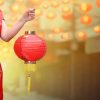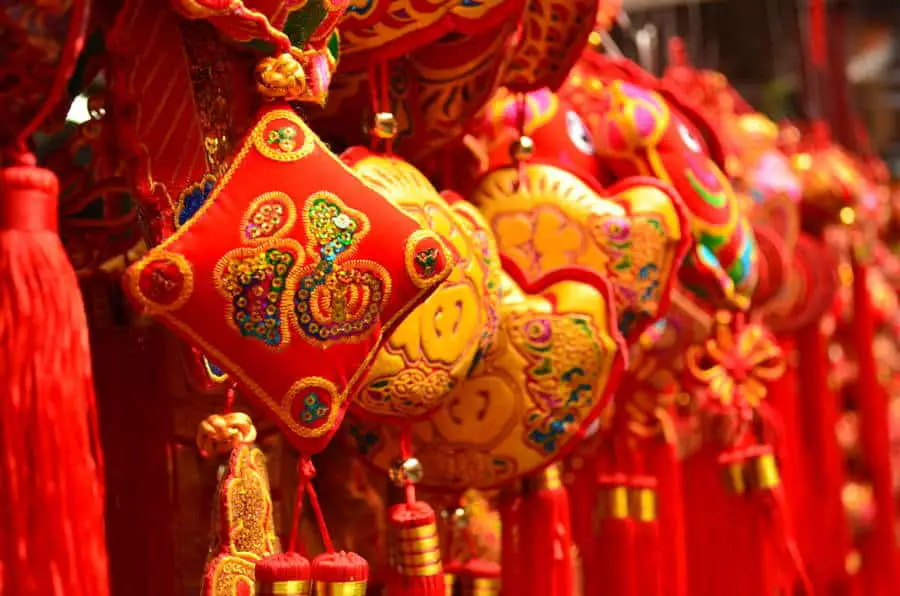
China, as well as many other Eastern cultures, is deeply rooted in Eastern philosophy and metaphysics, with symbolism plays a very big role even in today’s Chinese culture in the form of Feng Shui.
An important characteristic of Feng Shui is to use charms and decorations to enhance your house’s or business’s harmony with its surroundings, which is believed to improve positive energy while also protecting it from bad luck.
Below we will discuss some of the most popular good luck charms in Chinese culture and Feng Shui
1. Dzi Beads
Dzi beads (pronounced “zee”) actually don’t come from China but from Tibet. The Tibetan word Dzi translates to “shine” or “brightness” and in China Dzi beads are also known as 天珠; tin zhū, literally translated to “heaven’s bead”.

Typically made of agate by carving unique patterns and markings onto the stone, Dzi beads are also popular in Chinese Feng Shui practices as a good luck charm. Dzi stones are believed to be effective not only in repelling negative energy but also in storing positive energy for the owner’s luck.
Dzi stones can come in various designs and patterns from circles, stripes, wave patterns, and more. Commonly worn as bracelets, part of a necklace, or amulets.
Check out some Dzi beads designs – Opens in new tab.
2. Lucky Chinese emperor Coins
Chinese metal money, typically copied from actual money from the Qing dynasty (1644 to 1911 CE). Qing emperors typically minted their own coins and can be made of brass, bronze, or copper. Gold and silver are pretty rare back in the days, so gold and silver coins are very rare.
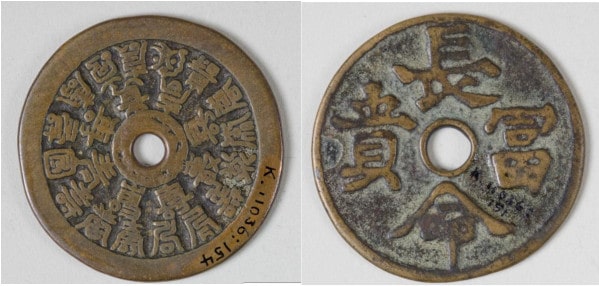
You can easily distinguish ancient Chinese coins with its square hole/cut-out in the middle. The round shape of the coin symbolizes heaven, while the square opening signified earth.
The fronts of the coins are usually inscribed with four characters flanking the four sides of the square hole. This is the yang side of the coin. On the other side, the yin side, there are up to two characters (can be blank).
There are a variety of ways to use these coins as a good luck charm, usually by tying three coins with a red-colored string or ribbon. Coin charms are believed to attract financial luck and money energy.
Check out some “Lucky Chinese emperor Coins” designs – Opens in new tab.
3.Laughing Buddha
One of the most common good luck charms in Chinese Feng Shui is the Laughing Buddha or Buddha of Happiness. This charm symbolizes good fortune, prosperity, fertility, health, and wealth.
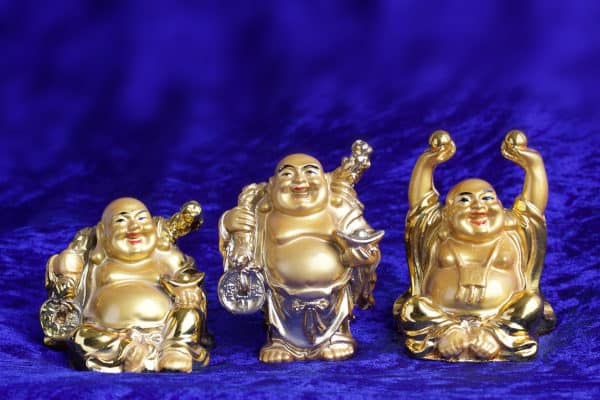
The Laughing Buddha is based on the story of a Buddhist monk that is believed to live in 10th-century China. This monk is rather eccentric and doesn’t fit in the typical serene and peaceful characteristics of a Buddhist monk, but was always happy with a loving heart, so he was loved by many. This monk is considered to be the reincarnation of Gautama Buddha, and is believed to symbolize joy, laughter, and happiness.
As a good luck charm, the Laughing Buddha can be placed anywhere in your house, except for the bathroom/toilet. However, typically they are placed in your living room or any areas in your house/business that are associated with money.
Check out some “Laughing Buddha” designs – Opens in new tab.
4.Lucky Fortune Cat
The lucky fortune cat is based on the Japanese Maneki-Neko and is a very common charm in Feng Shui. Different colors of the cat can symbolize different thing, and whether the cat is raising its left or right pay would symbolize different things.
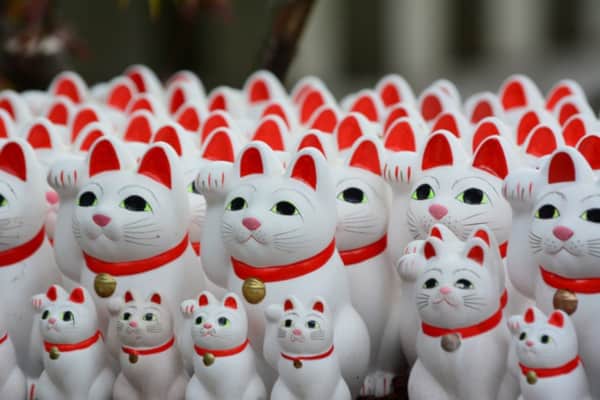
If the cat is raising its left paw, it is typically symbolizing a male cat that attracts wealth, fortune, and career success in business. So, you can place it in your office/area where you usually work to improve your success.
If, on the other hand, the cat is raising its right pay, then it is a female cat that symbolizes prosperity, fertility, and familial happiness, as well as good health. It is suitable to place this cat in your house or brick-and-mortar businesses.
Check out some “Lucky Fortune Cat” designs – Opens in new tab.
5.Wealth Ship
The Wealth Ship is also a very important charm in Chinese Feng Shui. As the name suggests, this is a ship-shaped display decoration with various shapes and sizes. They typically carry gems and mini-treasures to symbolize wealth and is very popular to place in homes and businesses.
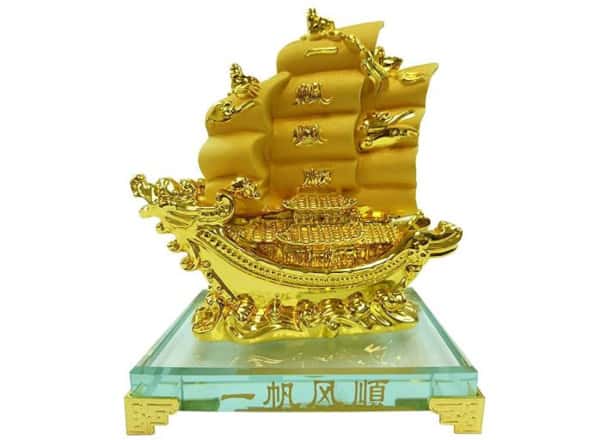
The wealth ship is believed to attract wealth and overall good fortune, and for correct Feng Shui, typically the ship has tail sails catching the wind in full flight to symbolize moving forward to a better future.
There are wealth ships that are fully made with precious gemstones and even gold, but there are also those that are built with real wood and cloth silk just like an authentic ship.
Check out some “Wealth Ship” designs – Opens in new tab.
Online Courses about Chinese Culture from Udemy (Aff.link)
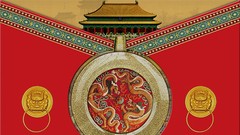
6.Three-Legged Money Frog
金 (Jin Chan) or also called 蜍 (Chan Chu) or the three-legged money frog is also one of the most popular and powerful good luck charms in Chinese Feng Shui. It is believed to attract and protect your wealth and fortune, while at the same time also protecting you and your family from bad luck.
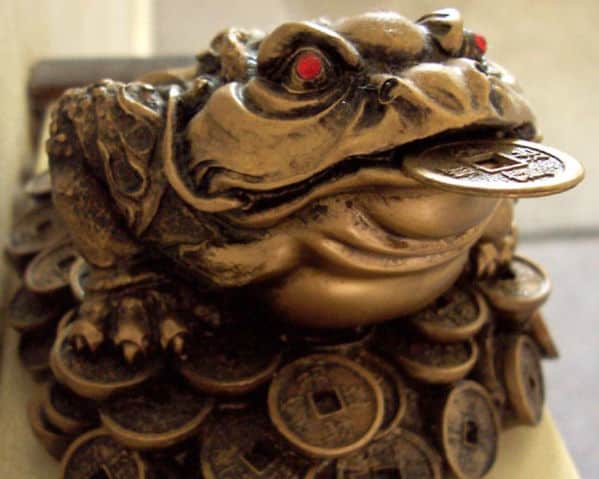
The three-legged money frog symbolizes the flow of money, and Feng Shui dictates that this statue should not be positioned facing your main door. Also, it shouldn’t be placed in your kitchen and toilet/bathroom.
Instead, a common practice is to place the three-legged money frog statue facing the main entrance, while another statue beside it has its back facing the entrance. This configuration is believed to protect the flow of the money coming and going outside the house/business.
Check out some “Three-Legged Money Frog” designs – Opens in new tab.
7.Amethyst Crystal Tree
In Chinese Feng Shui, crystals are believed to contain positive healing energy, and so many people are using them to aid as a focus object in their meditation practice.
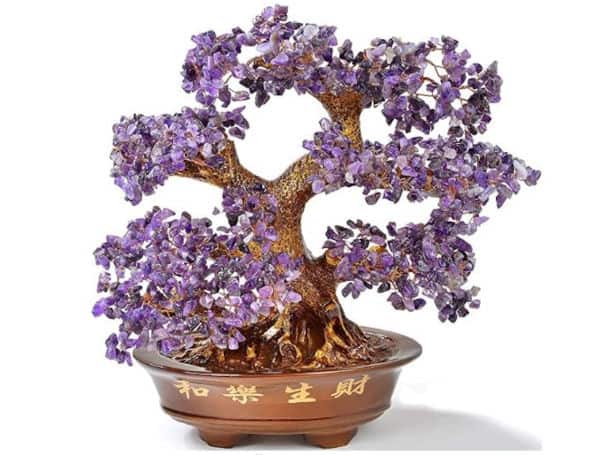
In this case, the amethyst crystals are arranged like a tree (with a resin/plastic tree branch) and are believed to contain healing properties to calm one’s mind. It is also considered a good luck charm for wealth and prosperity. The amethyst crystal tree can also help with insomnia and is believed to enhance memory while maintaining your calmness.
There are also crystal trees made from other materials like agate, citrine, rose quartz, and others. Citrine crystal tree, for example, is believed to aid
Check out some “Feng Shui Crystal Tree“ designs – Opens in new tab.
8.Dragon Turtle
Dragon and Turtle are the symbols of protection, wisdom, and nobility in Chinese culture, one of the four celestial animals (Dragon, Tiger, Phoenix, and turtle).
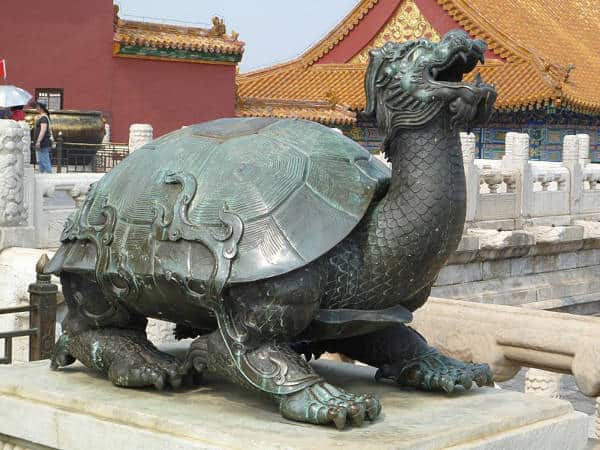
The Dragon Turtle, as the name suggests, has the body of a turtle but the head of a dragon, and is believed to symbolize good health, longevity, power, courage, and success. A Dragon Turtle statue is believed to protect its owner from betrayal in businesses and to promote healthy harmony within the home and business/workplace.
There are several different types of Dragon Turtle statues used as good luck charms, three of the most notable ones are:
- Dragon Turtle carrying a pagoda (the Wen Chang Pagoda) on its back. This is a good luck charm for academic success
- Dragon Turtle with a baby (or a couple of babies) sitting on its shell. Believed to improve fertility and family harmony
- Dragon Turtle sitting on coins and gold ingots, as you might have guessed, symbolizes financial fortune
Check out some “Dragon Turtle” designs – Opens in new tab.
9.Pi Yao or Pi Xiu
貔貅 (píxiū), also known as Pi Yao, Tian Lu, Bai Jie, or Bi Xie, is a Chinese mythical chimera creature resembling a winged lion with elements of dragons. As a good luck charm in Feng Shui, Pi Yao statues are believed to protect their owners from evil spirits and negative energy, preventing bad luck.
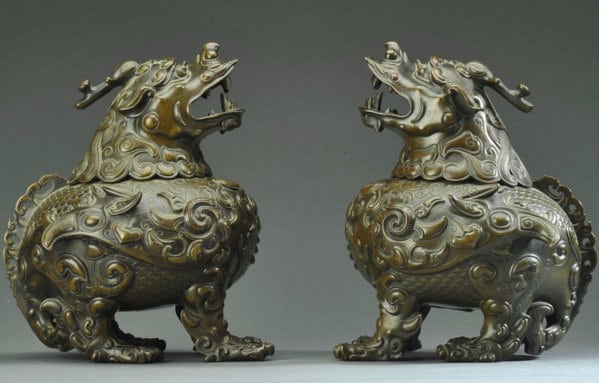
The legend also said that a Pi Xiu has a mouth and can earth anything but has no anus, so it won’t excrete anything. Pi Xio loves to eat gold, jewels, silver, and water, so it is believed that it will take wealth from all directions for its owner and as its food.
The Pi Xiu is believed to be a very loyal and obedient mythological animal, making it a favorite as a good luck charm for personal protection. You can find Pi Xiu charms in various different forms from keychains, to bracelets, or even statues.
Check out some “Pi Yao” designs – Opens in new tab
10.Chi Lin
Chi Lin is another mythological chimera from ancient China, a creature with the head of a dragon but the body of a horse. Also, Chi Lin has the scales of a carp fish. Chi Lin is also often called the Dragon Horse or sometimes, the Chinese Unicorn.
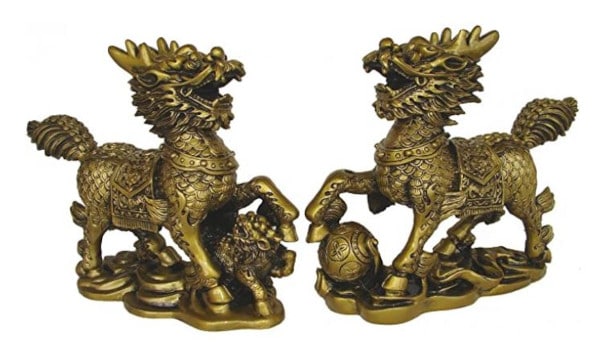
Chi Lin is believed to provide protection to its owner, and also to improve the owner’s health and wealth. On top of that, it is also known to be a protector against various relationship problems to promote a harmonious household. However, it is especially associated with fertility luck, so it
As a good luck charm, you can place the Chi Lin sculpture near your house’s or workplace’s main entrance or in your living room. It can also come in various other forms like embroidery of Chi Lin images, tassel, keychains, amulets, and so on. It also comes in many different materials, finishes, and sizes.
Check out some “Chi Lin” designs – Opens in new tab
11.Fu Dog
Fu dog, or also called Foo Dog is another mythological creature believed to be the Imperial Guardian Lion. Traditionally they are placed in front of imperial palaces, government offices in ancient China, and also temples.
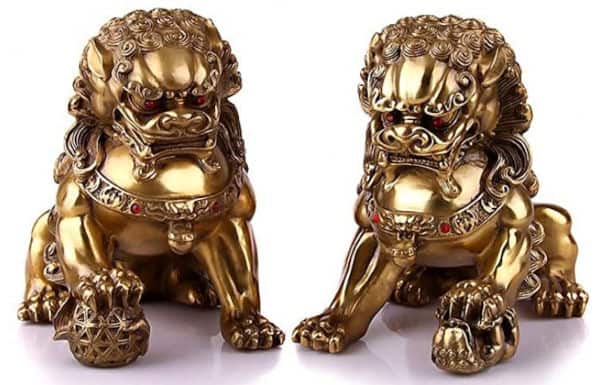
Nowadays, the Fu Dogs are considered a symbol of a family’s wealth and social status, and so they are often placed in front of big houses in China and Asia.
Typically Fu Dog statues are displayed as a couple, with the female Fu Dog holding a cub under her left pay, symbolizing maternal protection, and the male Fu Dog holding a globe under his right pay, signifying protection of his domain (the house).
The lion is not an indigenous animal in China, and this is why the stylized statues are more relatable to a dog, giving the name Fu Dog.
Check out some “Fu Dog” designs – Opens in new tab
12.Lucky Bamboo
The lucky bamboo is a very important plant in Feng Shui and is believed to bring positive, peaceful energy into the house it is located in. Bamboo is a flexible plant that is also hollow on the inside, and in Chinese philosophy, this symbolizes flexibility and open-mindedness of one’s mind.
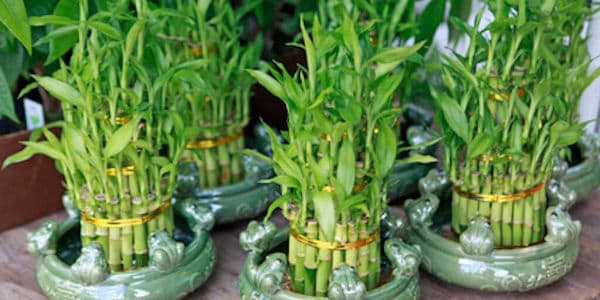
The lucky bamboo can be placed inside the home, or you can also grow real bamboo plants in your garden. There are also various accessories and charms made from bamboo stalks that are believed to produce the same effect.
The number of stalks also plays an important role in using Lucky Bamboo as a Feng Shui charm. Three stalks, for example, are believed to bring three kinds of luck: wealth, longevity, and happiness. Seven stalks, on the other hand, are believed to symbolize good health while eight stalks bestow fertility luck since the word “eight” in Mandarin sounds very similar to the word used for “grow”.
Check out some “Lucky Bamboo” – Opens in new tab
13.The Double Happiness Sign
The Chinese double happiness symbol basically consists of the word (xi) that is written twice side by side so that the two of its strokes are joined together.
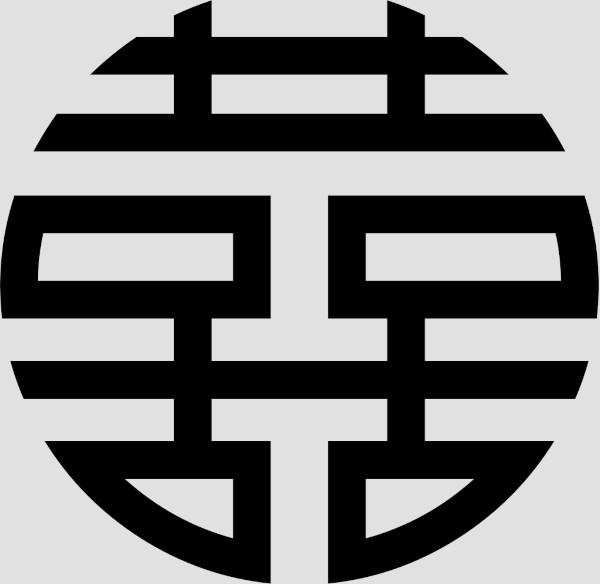
The meaning of this symbol is quite literal: double the happiness for the owner, and it is often used as decorations during festivities and celebrations (i.e. Chinese New Year, birthday parties, the birth of a child, etc.)
The double happiness sign originally started as a wedding decoration, a symbol of prayer wor the newlyweds for a happy and lasting marriage. However, throughout the years, it has made its way to other Chinese festivities.
Check out some “Double Happiness Sign“ Decorations – Opens in new tab
14.Phoenix
One of the four guardians of China (Dragon, Turtle, Phoenix, and TIger), Phoenix reigns over all other birds in China.
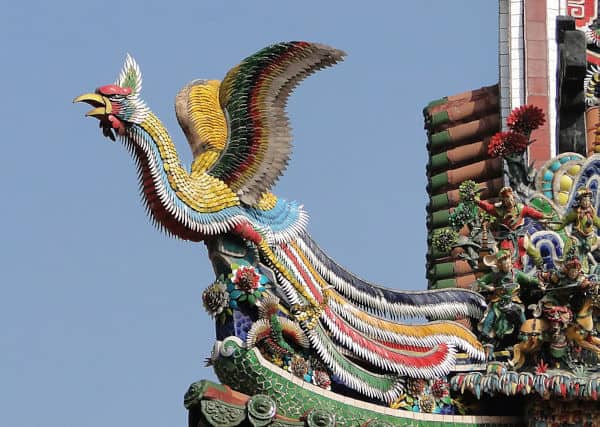
The male Phoenixes are called Feng, while the female ones are called Huang. However, gender distinction is no longer typically made today, and so the Phoenix is often called Fenghuang, a feminine entity pairing with the dragon, which typically is a male entity.
As a good luck charm, Phoenix sculptures represent justice, obedience, and fidelity, and is often used as a charm for those that are experiencing bad luck as it is believed to be capable of making turnarounds in bad circumstances.
Related reading: Beyond Miracles: Understanding the Real Impact of Feng Shui on Luck – Opens in new tab
15. Koi Fish
Koi is called 鲤鱼, Li Yu, or literally translated to “carp fish” in China. There are plenty of implementations as a good luck charm, for example, a carp statue placed on a study desk is believed to bring educational success.
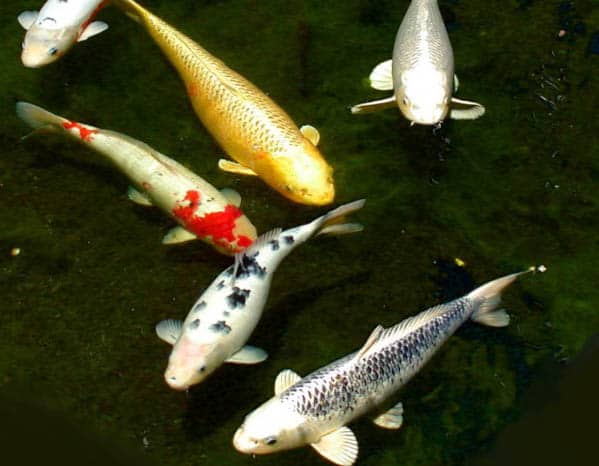
A common practice is to place 8 pieces of carp around the work desk since 8 is the Chinese number of wealth and prosperity. A couple of carp statues placed in the bedroom is also believed to bring happiness to a marriage.
Check out some “Koi Fish” Decorations – Opens in new tab
Want to learn more about Feng Shui? Check out our suggestions: Feng Shui Bookshelf – Opens in new tab
Stay in Touch
 Join our newsletter by using the forms on this website or click here!
Join our newsletter by using the forms on this website or click here! Follow us on Google News
Follow us on Google News Follow us on Facebook
Follow us on Facebook
Featured Image: “7- Lucky Charm” by lagalag15 is licensed under CC BY 2.0

